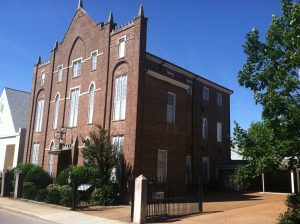The Native American protest of President Donald Trump’s visit Wednesday to the Hermitage tomb of Andrew Jackson in part started in Franklin nearly 200 years ago.
On a spring day in 1830 at the Masonic Lodge, still standing today on 2nd Avenue, Jackson and Chickasaw tribal leaders signed a major Indian relocation treaty. It was one of the first official steps in an unfortunate process that led seven years later to the infamous Trail of Tears.
On Thursday afternoon, State Representatives Charles Sargent, Williamson County, and Steve McDaniel, Jackson, visited the historic hall for a tour with Rachel Finch, Preservation Consultant for the Historic Franklin Masonic Hall who has spent more than a year researching and reviving its story.
The tour began in the main hall with Finch sharing that story with the legislators. Built in 1823 and continuously used by the Masons since, the building is undergoing an ongoing restoration. The tour was provided for the legislators, who helped secure a $50,000 contribution from the state last year.
“I have been through here a number of times before, and every time there is something more to learn”, Sargent said.
The hall has seven layers of paint, going back to the original coat. Finch found similar layers of history to peel through in her research.
When the temple, home of Hiram Lodge No.7, was built it was the first three-story building not just in Franklin, but the entire state of Tennessee. Not only that, but at the time it was the tallest building west of the Allegheny Mountains.
Since its completion it has been the home of the local masonry, making it one of the longest continuously-occupied Masonic Lodges in the country.
Due to its prominence and because his Secretary of War lived in town, President Andrew Jackson used the lodge as the location where he signed a treaty with the Chickasaw Indians in 1830.
After his Indian Removal Act was passed in May of 1830, authorizing the president to grant unsettled lands west of the Mississippi in exchange for Indian lands within existing state borders, Jackson invited the Chickasaw Nation to a treaty council to be held the following August in Franklin.
During their stay, the Chickasaw delegation met Jackson in the Franklin Masonic Hall, the one still standing today.
The Choctaw Nation originally proposed the council and requested that Jackson meet with them in person. The Choctaw backed out at the last minute because of internal disagreements, but Jackson did travel to Franklin to meet with the Chickasaw leaders. This would be the first treaty negotiation under the Removal Act and a successful outcome was important to the President, who was a charismatic and influential figure among the Chickasaw. Some of the older minkos (chiefs or headmen) had served under Jackson’s command at the Battle of New Orleans and the Creek War, during the War of 1812. They called him “Sharpe Knife”.
Jackson appointed John Coffee and John Eaton as treaty commissioners. Coffee was a long time friend who had also served with Jackson in 1812. Eaton, Jackson’s Secretary of War, lived in Franklin.
A few decades later, instead of a place where conflict ended; it was right in the thick of battle. During the Battle of Franklin, the lodge served as an observation post and hospital.
As tension mounted between the south and north in the build up to secession, Masons across the country pushed for peace, according to the National Register of Historic Places.
James McCullum, Grand Master of Tennessee, urged:
“The brethren engaged in the lawful contest to remember that a fallen foe is a brother, and as such is entitled to warmest sympathies and kindliest attention.”
In the Spring of 1861, after the southern states seceded one by one then together that winter, local women, including Carrie McGavock of Carnton Plantation and her slave Mariah. gathered in the lodge to sew Confederate uniforms.
During Union occupation in 1863, the Hall became quartermaster offices and barracks for the 14th Michigan and 2nd Michigan Cavalry regiments.
Local Union sympathizers, some of whom were Masons, were encouraged by the Federal troops to hold Unionist rallies.
Masons Dr. Daniel Cliffe, Dr. Samuel Henderson, Frank Hardeman, and non-Masons W.S. Campbell and A.J. Pinkston met at the lodge and prepared for the first rally, to be on Saturday, August 22, 1863.
Later, when the war came back to Franklin on November 30, 1864, the Masonic Hall served as a field hospital after the Battle of Franklin. The Lodge later received reparations for damage sustained during the war.
After the war, freed men settled along present-day Second Avenue, in a neighborhood that came to be called “Bucket of Blood.” According to local legend, this colorful name resulted from a knife fight in Pig Hodges poolroom, in which the victim bled a bucketful of blood.
Tension and prejudices grew from this- a riot occurred downtown on July 6, 1867, as the primarily African American Union League clashed with former Confederate sympathizers, shuttering the Masonic meeting that night.



















